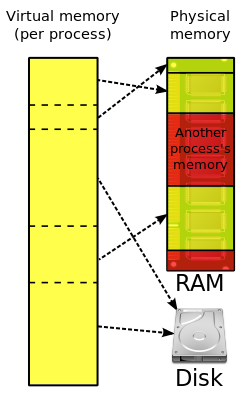
Back ذاكرة افتراضية Arabic Віртуальная памяць BE-X-OLD Memòria virtual Catalan Virtuální paměť Czech Virtuel hukommelse Danish Virtuelle Speicherverwaltung German Εικονική μνήμη Greek Virtuala memoro Esperanto Memoria virtual Spanish Virtuaalmälu Estonian

In computing, virtual memory, or virtual storage,[b] is a memory management technique that provides an "idealized abstraction of the storage resources that are actually available on a given machine"[3] which "creates the illusion to users of a very large (main) memory".[4]
The computer's operating system, using a combination of hardware and software, maps memory addresses used by a program, called virtual addresses, into physical addresses in computer memory. Main storage, as seen by a process or task, appears as a contiguous address space or collection of contiguous segments. The operating system manages virtual address spaces and the assignment of real memory to virtual memory.[5] Address translation hardware in the CPU, often referred to as a memory management unit (MMU), automatically translates virtual addresses to physical addresses. Software within the operating system may extend these capabilities, utilizing, e.g., disk storage, to provide a virtual address space that can exceed the capacity of real memory and thus reference more memory than is physically present in the computer.
The primary benefits of virtual memory include freeing applications from having to manage a shared memory space, ability to share memory used by libraries between processes, increased security due to memory isolation, and being able to conceptually use more memory than might be physically available, using the technique of paging or segmentation.
Cite error: There are <ref group=lower-alpha> tags or {{efn}} templates on this page, but the references will not show without a {{reflist|group=lower-alpha}} template or {{notelist}} template (see the help page).
- ^ "SYSTEM COMPONENTS: Dynamic Relocation" (PDF). System/360 Model 67 Time Sharing System Preliminary Technical Summary (PDF). IBM. 1966. p. 21. C20-1647-0.
- ^ "BCP (Base Control Program)" (PDF). z/OS Version 2 Release 4 z/OS Introduction and Release Guide (PDF). IBM. 22 September 2020. p. 3. GA32-0887-40.
- ^ Bhattacharjee, Abhishek; Lustig, Daniel (2017). Architectural and Operating System Support for Virtual Memory. Morgan & Claypool Publishers. p. 1. ISBN 9781627056021. Retrieved 16 October 2017.
- ^ Haldar, Sibsankar; Aravind, Alex Alagarsamy (2010). Operating Systems. Pearson Education India. p. 269. ISBN 978-8131730225. Retrieved 16 October 2017.
- ^ Zhou, Xiangrong; Petrov, Peter (1 December 2008). "Direct address translation for virtual memory in energy-efficient embedded systems". ACM Transactions on Embedded Computing Systems. 8 (1): 1–31. doi:10.1145/1457246.1457251. ISSN 1539-9087. S2CID 18156695.
© MMXXIII Rich X Search. We shall prevail. All rights reserved. Rich X Search